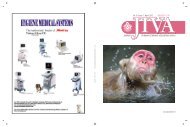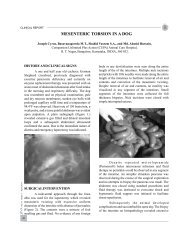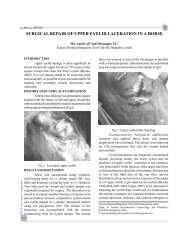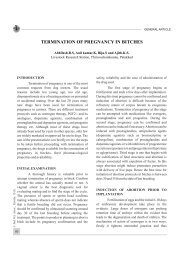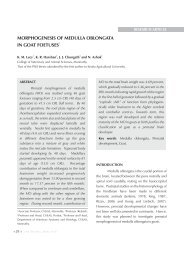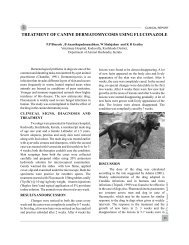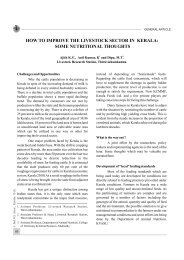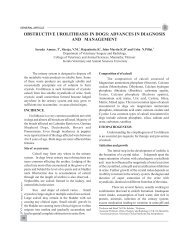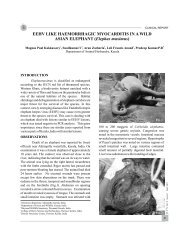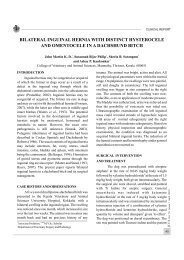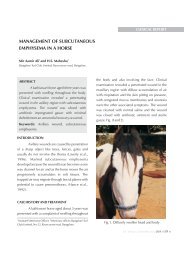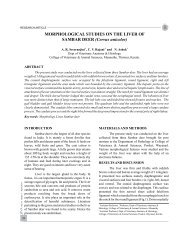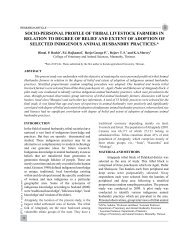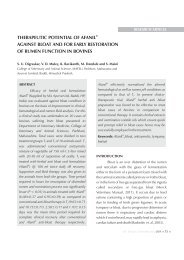oxyspirura mansoni in backyard poultry of kerala - Jivaonline.net
oxyspirura mansoni in backyard poultry of kerala - Jivaonline.net
oxyspirura mansoni in backyard poultry of kerala - Jivaonline.net
Create successful ePaper yourself
Turn your PDF publications into a flip-book with our unique Google optimized e-Paper software.
CLINICAL REPORT<br />
Oxyspirura <strong>mansoni</strong><br />
IN BACKYARD POULTRY OF KERALA<br />
1 2 2 2<br />
Deepu Philip Mathew , Priya M .N ., Deepa C.K ., Syamala K .,<br />
2 2<br />
Ajithkumar K. G . and Reghu Rav<strong>in</strong>dran<br />
College <strong>of</strong> Veter<strong>in</strong>ary and Animal Sciences, Pookot<br />
ABSTRACT:<br />
A few birds reared by a private owner as <strong>backyard</strong> <strong>poultry</strong> were brought to the Veter<strong>in</strong>ary Dispensary,<br />
Thiruvanvandoor, with the compla<strong>in</strong>t <strong>of</strong> <strong>in</strong>ability to open the eyes. Irritation and secretion <strong>of</strong> tears from the eyes<br />
<strong>of</strong> birds were observed. White, small, thread like nematode worms recovered from the eyes, The worms were<br />
identified as Oxyspirura <strong>mansoni</strong> based on morphology.<br />
INTRODUCTION:<br />
Despite a tremendous <strong>in</strong>crease <strong>in</strong> the commercial<br />
rear<strong>in</strong>g, rural <strong>poultry</strong> still constitutes 80 per cent <strong>of</strong><br />
our total <strong>poultry</strong> population. Though the prevalence<br />
<strong>of</strong> parasitic <strong>in</strong>fections are less <strong>in</strong> commercial<br />
system due to the non availability <strong>of</strong> <strong>in</strong>termediate<br />
hosts, helm<strong>in</strong>th <strong>in</strong>fections are high <strong>in</strong> free range and<br />
<strong>backyard</strong> systems due to exposure to reservoir<br />
hosts and unscientific management practices<br />
(Perm<strong>in</strong> et al., 1999). The present study deals with<br />
the occurrence <strong>of</strong> Oxyspirura <strong>mansoni</strong>, the eye<br />
worm <strong>of</strong> chicken.<br />
MATERIALS AND METHODS:<br />
The birds were brought to Veter<strong>in</strong>ary<br />
Dispensary, Thiruvanvandoor, Alappuzha with the<br />
compla<strong>in</strong>t <strong>of</strong> <strong>in</strong>ability to open the eyes and<br />
protrusion <strong>of</strong> the nictitat<strong>in</strong>g membrane. The owner<br />
compla<strong>in</strong>ed <strong>of</strong> irritation and <strong>in</strong>flammation with<br />
secretion <strong>of</strong> tears from the eyes <strong>of</strong> birds. The birds<br />
were reared as back yard <strong>poultry</strong> by the farmer.<br />
Exam<strong>in</strong>ation <strong>of</strong> eyes revealed the presence <strong>of</strong> large<br />
number <strong>of</strong> live worms under the nictitat<strong>in</strong>g<br />
membrane. Worms recovered from the eyes were<br />
sent to the Department <strong>of</strong> Veter<strong>in</strong>ary Parasitology,<br />
1. Veter<strong>in</strong>ary surgeon, Veter<strong>in</strong>ary Dispensary,<br />
Thiruvanvandoor, Alapuzha<br />
2. Assistant Pr<strong>of</strong>essor Department <strong>of</strong> Veter<strong>in</strong>ary Parasitology,<br />
College <strong>of</strong> Veter<strong>in</strong>ary and Animal Sciences, Pookot, Lakkidi,<br />
P. O., Wayanad.<br />
College <strong>of</strong> Veter<strong>in</strong>ary and Animal Sciences, Pookot<br />
for identification.<br />
These parasites were then processed by<br />
dehydrat<strong>in</strong>g <strong>in</strong> ascend<strong>in</strong>g grades <strong>of</strong> alcohol<br />
followed by clear<strong>in</strong>g us<strong>in</strong>g creosote. The species<br />
was identified based on morphology accord<strong>in</strong>g to<br />
Soulsby (1982).<br />
RESULT:<br />
The worms were white, small and thread<br />
like measur<strong>in</strong>g a little over half an <strong>in</strong>ch <strong>in</strong> length.<br />
The male worms were smaller than the females.<br />
Microscopically, the mouth open<strong>in</strong>g was large,<br />
circular and devoid <strong>of</strong> lips. The pharynx was<br />
observed to be hourglass shaped (Fig.1). The tail<br />
end <strong>of</strong> the male was curved ventrally while <strong>in</strong><br />
females it was straight. Two unequal spicules were<br />
present on the posterior end <strong>of</strong> the males. One <strong>of</strong> the<br />
spicule was long and slender while the other was<br />
short and thick (Fig. 2). There were six pairs <strong>of</strong><br />
genital papillae on the posterior end <strong>of</strong> the male. In<br />
the female, the vulva was located ventrally <strong>in</strong> the<br />
posterior half <strong>of</strong> the body.<br />
The worms were<br />
identified as Oxyspirura <strong>mansoni</strong> based on Soulsby<br />
(1982). The affected birds were treated with<br />
Albendazole 2.5 percent suspension topically by<br />
<strong>in</strong>still<strong>in</strong>g a drop each <strong>in</strong>to the eyes two times a day<br />
for 3 days consecutively. The complete flock<br />
<strong>in</strong>clud<strong>in</strong>g the affected birds was dewormed with<br />
JIVA Vol. 10 Issue 1 April 2012<br />
43
CLINICAL REPORT<br />
J. Ind. Vet. Assoc., Kerala. 10 (1)<br />
Fig.1: Oxyspirura <strong>mansoni</strong>- anterior end-<br />
Hour glass shaped pharynx<br />
Fig.2: Oxyspirura <strong>mansoni</strong>- male tail end- long<br />
left spicule and short right spicule<br />
Albendazole 2.5 per cent suspension orally at the<br />
dose rate <strong>of</strong> 25 mg/kg body weight. The treatment<br />
regimen resulted <strong>in</strong> complete recovery <strong>of</strong> all the<br />
affected birds.<br />
DISCUSSION:<br />
Previously, Pillai and Peter (1971) and<br />
Nadkal et al., (1972) have reported the occurrence<br />
<strong>of</strong> O. <strong>mansoni</strong> <strong>in</strong> Kerala. Based on available<br />
literature, there is no report <strong>of</strong> the parasite from the<br />
state s<strong>in</strong>ce 1972. This may be due to the lack <strong>of</strong><br />
surveys for detection <strong>of</strong> worms from <strong>poultry</strong>.<br />
44<br />
Eventhough the prevalence <strong>of</strong> most<br />
parasitic diseases <strong>in</strong> <strong>poultry</strong> has reduced<br />
significantly due to commercial <strong>poultry</strong><br />
production, a number <strong>of</strong> helm<strong>in</strong>th species are<br />
observed <strong>in</strong> rural scaveng<strong>in</strong>g <strong>poultry</strong> (Pandey et al.,<br />
1992, Perm<strong>in</strong> et. al., 1997 and Kabatange and<br />
Katule, 1990). Larvae <strong>of</strong> Oxyspirura <strong>mansoni</strong><br />
develop <strong>in</strong> the body cavity <strong>of</strong> the cockroach on<br />
<strong>in</strong>gestion <strong>of</strong> embryonated eggs that are passed<br />
through faeces <strong>of</strong> affected birds. Ingestion <strong>of</strong><br />
<strong>in</strong>fected cockroaches leads to <strong>in</strong>fection (Soulsby,<br />
1982). The movement <strong>of</strong> the worms <strong>in</strong> the eye,<br />
results <strong>in</strong> irritation ophthalmitis and abundant<br />
secretion <strong>of</strong> tears lead<strong>in</strong>g to self <strong>in</strong>flicted <strong>in</strong>jury.<br />
The nictitat<strong>in</strong>g membrane becomes swollen and<br />
may protrude out <strong>of</strong> the corner <strong>of</strong> the eye (Flynn,<br />
2007).<br />
REFERENCES:<br />
Kabatange, M.A, and Katule, A.M 1990 Rural<br />
<strong>poultry</strong> production systems <strong>in</strong> Tanzania. In:<br />
Proceed<strong>in</strong>gs <strong>of</strong> an <strong>in</strong>ternational workshop on<br />
rural <strong>poultry</strong> <strong>in</strong> Africa, African Network on<br />
Rural Poultry Development, Nigeria. pp.<br />
171-176<br />
Nadkal, A.M., John, K.C., Muraleedharan, K and<br />
Mohandas, A. 1972 Qualitative analysis <strong>of</strong><br />
gastro<strong>in</strong>test<strong>in</strong>al helm<strong>in</strong>ths <strong>of</strong> domestic fowl<br />
<strong>in</strong> southern Kerala. Ind. J. Anim. Health 11:<br />
5-9.<br />
Perm<strong>in</strong> A, Magwisha H, Kassuku AA, Nansen P,<br />
Bisgaard M, Frandsen F, Gibbons L (1997) A<br />
cross-sectional study <strong>of</strong> helm<strong>in</strong>ths <strong>in</strong> rural<br />
scaveng<strong>in</strong>g <strong>poultry</strong> <strong>in</strong> Tanzania <strong>in</strong> relation to<br />
season and climate. J. Helm<strong>in</strong>thol. 71: 233-<br />
240.<br />
Pillai, K.M., Peter, C.T. 1971 Studies on tapeworms<br />
commonly encountered <strong>in</strong> fowls. Ind. Vet. J.<br />
48: 430-431.<br />
Robert, J. Flynn and David, G. Baker 2007 Flynn's<br />
nd<br />
parasites <strong>of</strong> laboratory animals. 2 Edn.<br />
American College <strong>of</strong> Laboratory Animal<br />
Medic<strong>in</strong>e Blackwell publish<strong>in</strong>g pp: 250-251<br />
Soulsby, E.J.L. 1982 Helm<strong>in</strong>thes, arthropods and<br />
protozoa <strong>of</strong> domesticated animals. 7th Edn.<br />
Bailliere T<strong>in</strong>dall, London pp: 291WATT<br />
<strong>poultry</strong> statistical yearbook 1996 Poultry Intl<br />
35: 8



